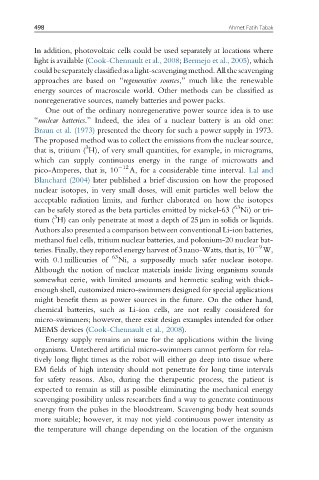Page 504 - Handbook of Biomechatronics
P. 504
498 Ahmet Fatih Tabak
In addition, photovoltaic cells could be used separately at locations where
light is available (Cook-Chennault et al., 2008; Bermejo et al., 2005), which
could be separately classified as a light-scavenging method. All the scavenging
approaches are based on “regenerative sources,” much like the renewable
energy sources of macroscale world. Other methods can be classified as
nonregenerative sources, namely batteries and power packs.
One out of the ordinary nonregenerative power source idea is to use
“nuclear batteries.” Indeed, the idea of a nuclear battery is an old one:
Braun et al. (1973) presented the theory for such a power supply in 1973.
The proposed method was to collect the emissions from the nuclear source,
3
that is, tritium ( H), of very small quantities, for example, in micrograms,
which can supply continuous energy in the range of microwatts and
12
pico-Amperes, that is, 10 A, for a considerable time interval. Lal and
Blanchard (2004) later published a brief discussion on how the proposed
nuclear isotopes, in very small doses, will emit particles well below the
acceptable radiation limits, and further elaborated on how the isotopes
63
can be safely stored as the beta particles emitted by nickel-63 ( Ni) or tri-
3
tium ( H) can only penetrate at most a depth of 25μm in solids or liquids.
Authors also presented a comparison between conventional Li-ion batteries,
methanol fuel cells, tritium nuclear batteries, and polonium-20 nuclear bat-
teries. Finally, they reported energy harvest of 3nano-Watts, that is, 10 9 W,
63
with 0.1millicuries of Ni, a supposedly much safer nuclear isotope.
Although the notion of nuclear materials inside living organisms sounds
somewhat eerie, with limited amounts and hermetic sealing with thick-
enough shell, customized micro-swimmers designed for special applications
might benefit them as power sources in the future. On the other hand,
chemical batteries, such as Li-ion cells, are not really considered for
micro-swimmers; however, there exist design examples intended for other
MEMS devices (Cook-Chennault et al., 2008).
Energy supply remains an issue for the applications within the living
organisms. Untethered artificial micro-swimmers cannot perform for rela-
tively long flight times as the robot will either go deep into tissue where
EM fields of high intensity should not penetrate for long time intervals
for safety reasons. Also, during the therapeutic process, the patient is
expected to remain as still as possible eliminating the mechanical energy
scavenging possibility unless researchers find a way to generate continuous
energy from the pulses in the bloodstream. Scavenging body heat sounds
more suitable; however, it may not yield continuous power intensity as
the temperature will change depending on the location of the organism

